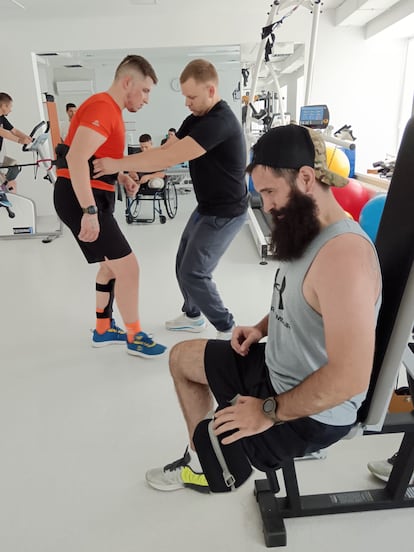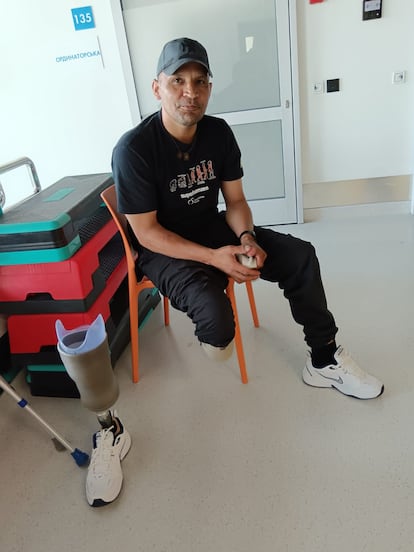Oleksandr Ivanko, 33, wants to dance with his wife again. It is his first wish. She looks at him from a distance, far enough away not to have heard him. But he also dreams of getting into the car and driving. And of playing with his two daughters, aged 8 and 15. Ivanko is a professional soldier. He is elusive in his story, distrustful and cautious. He does not want to give information that would compromise his family against the enemy. He has lived in many places during his life, but he stays in Poltava, a city in central Ukraine. Ivanko lost his right leg on 15 April. He was repairing the engine of a helicopter at a military position in the east of the country when a Kh-59 missile, one of the Russian devils, fell about 20 metres away and tore off his limb. “I have had many nightmares, but I have accepted the situation, I have good morale,” he says from a wheelchair in The Superhuman Center of the small municipality of Vinnikijust outside Lviv in western Ukraine. Ivanko is one of 70 patients at this state-of-the-art facility dedicated to the manufacture and treatment of prosthetics and reconstructive surgery for military and civilians. The waiting list exceeds two thousand.
In times of war, accurate data is scarce and half-truths abound. The most modest figure for amputees as a result of the Russian invasion is around 20,000, according to local organisations such as Pryncyp, dedicated to the defense of the rights of military personnel. The highest would be around 50,000. The challenge is huge with these victims: first because of the severity of their injuries; then by access to prostheses, limited and very expensive – they can range from 3,000 euros to more than 100,000, depending on the material and technology; finally, due to the harshness of the therapy and his psychosocial rehabilitation. In the case of soldiers, furthermore, their possible return to the front is complicated, although it is not impossible.
Losing a limb is not the same as being immobilized, just as being injured is not the same as losing your sense of humor. Private Ivanko, who served in eastern Congo before Ukraine, is a good example of this. Asked what he felt when the shell destroyed his leg, he says, with a little hesitation: “I immediately realized that instead of a car with gears, I would have to drive an automatic.” More seriously, he talks about his tomorrow, about when he can walk again. He wants to go back to the front. “The commander of my brigade tells me every day that he is waiting for me,” he says confidently.
The Superhuman Center, a name chosen to inject morale into patients and appeal to foreign donors, was born in April 2023 by the Ukrainian businessman Andrey Stavnitser, 42, co-founder of the port operator TIS, and the support (15 million euros) of the American Howard G. Buffett Foundation. The initiative aimed to make an almost impossible task more possible: caring for such a high number of mutilated citizens in such a short time. The Ukrainian State offers prosthetic assistance to its military. The Government has just approved a resolution to speed up access to highly functional prostheses, with costs ranging from 25,000 to 55,000 euros. But all this is not enough.
To be one of those Superhuman At the Vinniki facility, you have to fill out an application online and wait for a call. Every Friday, around ten patients finish the therapy and pass the baton to another ten who begin it. There are more than 700 candidates involved in the admission process, which can last weeks. An estimated 2,500 other people have applied to join the centre.
Knowing what’s happening outside means understanding what’s going to happen inside, so don’t miss anything.
KEEP READING

That is what Pavlo Romanovskii, 34, from the city of Dnipro, in the eastern part of the country, did. He sits on a padded bench on a weight-training machine, working out the stump of his left leg, amputated above the knee, moving it up and down. He closes his eyes and twists his face. He is suffering. He talks, without losing his smile, about Murphy’s cursed law, which made the only shell that fell on his position near Andriivka on the eastern front hit him just a hand’s width away on July 22, 2023. He doesn’t miss a single detail. He takes out his notebook and draws the launcher and the ammunition that severed his limb. He has a video of how he was left, with his leg and head bandaged. Romanovskii is a good example of what a wounded man is: scars all over his chest, damage to his hearing aid and 27 operations.
“I don’t feel disabled,” adds this soldier with a long beard. He soon realized that he had to be in shape, that he had to work hard in the gym to do what he had always loved, whether it was climbing, riding a motorcycle or doing kitesurfing. But there is still time for all that. His wife and five-year-old daughter are the driving force behind him, but he admits that he does not yet have “his old life.” He needs more time to get the hang of his prosthesis. He adjusts it naturally and grabs a small weight with his left arm to walk around the room. It is hard. And despite everything, he also wants to return to the front. “I will do it for my daughter and for all the children of Ukraine.” His brigade, he says, does accept uniformed personnel with amputations.
The theory, according to the mobilization law approved in April, says that men with bilateral amputation at any level or unilateral amputation of the lower limb above the upper third of the leg, are exempt. Another thing is the practice: firstly because the Ukrainian forces, outnumbered by the Russian uniformed men, need to multiply their troops and the m
ost veteran know this. Secondly, because there are many rearguard positions that can be filled despite having some prosthesis.
Oleksandr Kutsan, 36, from historic Pereyaslav, would be in the first group of this section of the new law. On March 19, 2023, in a position near Liman in the east, a shell shattered both of his legs. He still remembers, with a certain irony, how he himself, lying on the ground, had to teach a 19-year-old novice how to put on tourniquets. At least, the amputation of the left leg was done below the knee. It has taken him four months to master the prostheses. “It is difficult to keep balance with both,” he admits. Kutsan, who now chats from a wheelchair, is not one of those who wants to go back to battle. He collaborates with the Superhumans Center, showing visitors, among other things, the challenges of his new mobility. Life has changed radically for him, but there is someone who continues to make him laugh, consciously defeated by his pranks. “It is my motivation,” he says. His daughter.

Perhaps Kutsan is an exception among those who, despite pain and disability, gladly accept this new mission of Superhuman and they return to the ranks. Alban Torres, 43 years old, born in the Cauca Valley, in Colombia, does not conceive of anything other than returning with his battalion, the 204th. He is part of this international contingent that has been feeding the Ukrainian forces. “Money is not everything,” he explains, with extreme politeness, before recounting how he was wounded in the Donetsk sector by a drone that he calls a “kamikaze”; how he lost part of his right leg, suffered a bullet in the shoulder and had his ears crushed – he is trying out a new hearing aid, but still hears a lot of “noises” – and how he asked his companions to shoot him in the head so that he could die right there. “I realized that I was going to be a burden,” he says after finishing his exercises. He was transferred to a hospital in Konstiantinivka. Torres, a soldier with 20 years of service, has family in Colombia and his wife in Spain. He has been trying to leave the wheelchair for two weeks.
-What is the hardest?
―It takes one’s will to want to get up again.
Follow all the international information at Facebook and xor in our weekly newsletter.
Subscribe to continue reading
Read without limits
_
#war #amputees #superhumans #return #front
